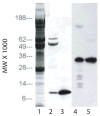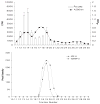IGF-II is present in bovine corneal stroma and activates keratocytes to proliferate in vitro
- PMID: 18237730
- PMCID: PMC2696166
- DOI: 10.1016/j.exer.2007.12.004
IGF-II is present in bovine corneal stroma and activates keratocytes to proliferate in vitro
Abstract
Extracts of bovine corneal stroma have been shown to activate keratocytes in culture to proliferate. We fractionated stromal extract on a column of Sephacryl S-300 and tested the fractions for mitogenic activity using cell culture and for the presence of IGF-II and its binding protein IGFBP-2 by Western blot. We found that the mitogenic activity in the extract separated into major and minor peaks and that immunologically detectable IGF-II and IGFBP-2 co-eluted with the minor peak. We also compared the effects of 10 ng IGF-II/ml on keratocytes in culture to that of 2 ng TGF-beta/ml over a 7-day culture period. We found that IGF-II and TGF-beta, alone or combined, increased both (3)H-thymidine incorporation and DNA content of the cultures. The phenotype of the cells was determined by using antibodies to alpha-SM (smooth muscle) actin, fibronectin, SPARC, lumican and keratocan in Western blots of cell layers of media. Keratocytes cultured in IGF-II expressed no alpha-SM actin or fibronectin, low levels of SPARC and high levels of lumican and keratocan, indicating a native phenotype. Keratocytes in TGF-beta expressed alpha-SM actin, fibronectin, SPARC and lumican, and expressed no or low levels of keratocan, indicating a myofibroblast phenotype. Keratocytes cultured in IGF-II plus TGF-beta, however, expressed alpha-SM actin, fibronectin, SPARC, lumican, and keratocan by day 7 of culture. The results of this study show that IGF-II to be present in the corneal stroma, to stimulate keratocyte proliferation while maintaining native phenotype and to override the TGF-beta mediated down regulation of keratocan production. The IGF-II in the stroma may serve as a mechanism to immediately activate keratocytes upon wounding and to ameliorate the scarring effects of TGF-beta.
Figures






Similar articles
-
The molecular basis of corneal transparency.Exp Eye Res. 2010 Sep;91(3):326-35. doi: 10.1016/j.exer.2010.06.021. Epub 2010 Jul 3. Exp Eye Res. 2010. PMID: 20599432 Free PMC article. Review.
-
The effect of growth factor supplementation on corneal stromal cell phenotype in vitro using a serum-free media.Exp Eye Res. 2016 Oct;151:26-37. doi: 10.1016/j.exer.2016.07.015. Epub 2016 Jul 22. Exp Eye Res. 2016. PMID: 27456135
-
FGF-2- and TGF-β1-induced downregulation of lumican and keratocan in activated corneal keratocytes by JNK signaling pathway.Invest Ophthalmol Vis Sci. 2011 Nov 21;52(12):8957-64. doi: 10.1167/iovs.11-8078. Invest Ophthalmol Vis Sci. 2011. PMID: 22025571 Free PMC article.
-
Keratocan expression of murine keratocytes is maintained on amniotic membrane by down-regulating transforming growth factor-beta signaling.J Biol Chem. 2005 Jul 22;280(29):27085-92. doi: 10.1074/jbc.M409567200. Epub 2005 May 20. J Biol Chem. 2005. PMID: 15908433 Free PMC article.
-
Keratocyte phenotype is enhanced in the absence of attachment to the substratum.Mol Vis. 2008 Feb 9;14:308-17. Mol Vis. 2008. PMID: 18334944 Free PMC article.
Cited by
-
Coupling of Fibrin Reorganization and Fibronectin Patterning by Corneal Fibroblasts in Response to PDGF BB and TGFβ1.Bioengineering (Basel). 2020 Aug 7;7(3):89. doi: 10.3390/bioengineering7030089. Bioengineering (Basel). 2020. PMID: 32784578 Free PMC article.
-
Transforming growth factor-β3 regulates assembly of a non-fibrotic matrix in a 3D corneal model.J Tissue Eng Regen Med. 2011 Aug;5(8):e228-38. doi: 10.1002/term.429. Epub 2011 May 23. J Tissue Eng Regen Med. 2011. PMID: 21604386 Free PMC article.
-
Head and neck squamous cancer stromal fibroblasts produce growth factors influencing phenotype of normal human keratinocytes.Histochem Cell Biol. 2010 Feb;133(2):201-11. doi: 10.1007/s00418-009-0661-6. Epub 2009 Nov 19. Histochem Cell Biol. 2010. PMID: 19924430
-
Expression of insulin-like growth factor 2 receptor in corneal keratocytes during differentiation and in response to wound healing.Invest Ophthalmol Vis Sci. 2014 Oct 30;55(12):7697-708. doi: 10.1167/iovs.14-15179. Invest Ophthalmol Vis Sci. 2014. PMID: 25358730 Free PMC article.
-
The molecular basis of corneal transparency.Exp Eye Res. 2010 Sep;91(3):326-35. doi: 10.1016/j.exer.2010.06.021. Epub 2010 Jul 3. Exp Eye Res. 2010. PMID: 20599432 Free PMC article. Review.
References
-
- Arnold DR, Moshayedi P, Schoen TJ, Jones BE, Chader GJ, Waldbillig RJ. Distribution of IGF-I and -II, IGF binding proteins (IGFBPs) and IGFBP mRNA in ocular fluids and tissues: potential sites of synthesis of IGFBPs in aqueous and vitreous. Exp Eye Res. 1993;56:555–565. - PubMed
-
- Beales MP, Funderburgh JL, Jester JV, Hassell JR. Proteoglycan synthesis by bovine keratocytes and corneal fibroblasts: maintenance of the keratocyte phenotype in culture. Invest Ophthalmol Vis Sci. 1999;40:1658–1663. - PubMed
-
- Berryhill BL, Beales MP, Hassell JR. Production of prostaglandin D synthase as a keratan sulfate proteoglycan by cultured bovine keratocytes. Invest Ophthalmol Vis Sci. 2001;42:1201–1207. - PubMed
-
- Berryhill BL, Kader R, Kane B, Birk DE, Feng J, Hassell JR. Partial restoration of the keratocyte phenotype to bovine keratocytes made fibroblastic by serum. Invest Ophthalmol Vis Sci. 2002;43:3416–3421. - PubMed
-
- Berryhill BL, Kane B, Stramer BM, Fini ME, Hassell JR. Increased SPARC accumulation during corneal repair. Exp Eye Res. 2003;77:85–92. - PubMed
Publication types
MeSH terms
Substances
Grants and funding
LinkOut - more resources
Full Text Sources
Other Literature Sources
Miscellaneous

